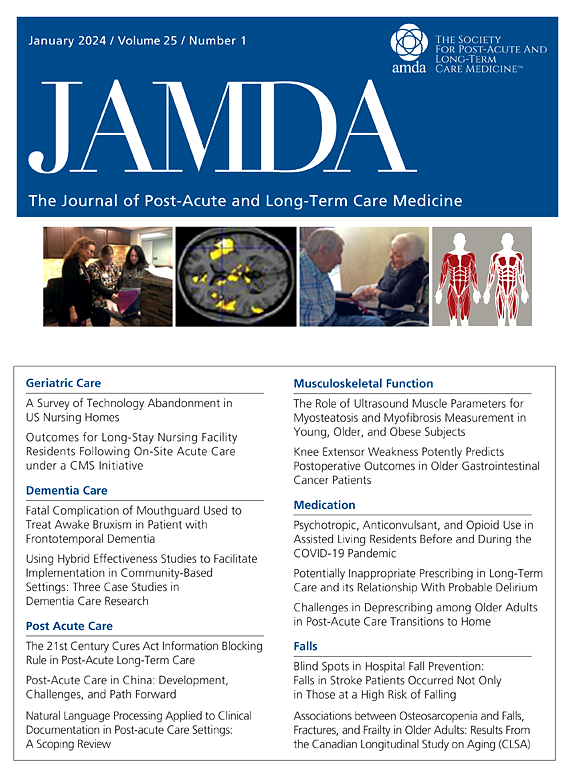Central Nervous System Polypharmacy Among People Living With Dementia
IF 4.2
2区 医学
Q2 GERIATRICS & GERONTOLOGY
Journal of the American Medical Directors Association
Pub Date : 2025-06-14
DOI:10.1016/j.jamda.2025.105708
引用次数: 0
Abstract
Objectives
The Centers for Medicare and Medicaid Services Polypharmacy-CNS (Poly-CNS) quality metric identifies individuals taking multiple medications with central nervous system side effects. The Poly-CNS measure may reduce risky prescribing for persons living with dementia (PLWD).
Design
Secondary analysis of the Optimize cluster randomized pragmatic trial of deprescribing education in primary care conducted between April 1, 2019, and March 31, 2020.
Setting and Participants
Two overlapping cohorts of PLWD taking 5+ chronic medications. The “full intervention” cohort was randomized at the clinic level to receive patient and clinician deprescribing education materials. The “clinician education cohort” included additional individuals whose clinicians received educational materials but who did not receive patient materials.
Methods
Description of individuals meeting Poly-CNS criteria based on pharmacy dispensing records and their highest frequency combinations of medications. Generalized linear mixed models compared the odds of meeting Poly-CNS criteria by intervention or control group and modeled associations between patient characteristics and CNS polypharmacy at any time. Longitudinal analysis using generalized linear mixed models assessed trends of meeting Poly-CNS criteria over time.
Results
The proportion meeting Poly-CNS criteria at any time during the observation period in the full intervention cohort (N = 2908) was 12.3% and 10.8% in the clinician education cohort (N = 5226). Adjusted P value for trend over time in the combined full intervention cohort was .0587, and <.0001 in the clinician education cohort. There was no effect of the intervention on odds of meeting Poly-CNS criteria in either cohort. Characteristics in both cohorts independently associated with meeting Poly-CNS criteria were younger age, greater morbidity burden, and female sex plus hospice use at baseline in the full intervention cohort. The most commonly combined medications were opioids plus antidepressants plus gabapentin.
Conclusions and Implications
Individuals with cognitive limitations and multimorbidity pharmacologically treated for mood and/or pain symptoms may be at risk for CNS polypharmacy.
痴呆症患者的中枢神经系统多药作用
目的:医疗保险和医疗补助服务中心的多药-中枢神经系统(多药-中枢神经系统)质量指标识别个体服用多种药物与中枢神经系统的副作用。多中枢神经系统测量可能会减少痴呆症患者(PLWD)的风险处方。设计:对2019年4月1日至2020年3月31日进行的初级保健中描述教育的优化聚类随机实用试验进行二次分析。环境和参与者:两个重叠的PLWD队列,服用5种以上的慢性药物。“完全干预”队列在临床水平随机分配,接受患者和临床医生描述的教育材料。“临床医生教育队列”包括额外的个体,他们的临床医生接受了教育材料,但没有接受患者材料。方法:根据药房配药记录及其最高频率药物组合描述符合多中枢神经系统标准的个体。广义线性混合模型比较干预组和对照组满足多中枢神经系统标准的几率,并模拟任何时候患者特征与多中枢神经系统之间的关联。使用广义线性混合模型的纵向分析评估了随着时间的推移满足Poly-CNS标准的趋势。结果:完全干预组(N = 2908)观察期内任何时间符合Poly-CNS标准的比例为12.3%,临床医生教育组(N = 5226)为10.8%。在联合全面干预队列中,随时间变化趋势的调整P值为0.0587,结论和意义:因情绪和/或疼痛症状而接受药物治疗的认知限制和多种疾病的个体可能存在中枢神经系统多药症的风险。
本文章由计算机程序翻译,如有差异,请以英文原文为准。
求助全文
约1分钟内获得全文
求助全文
来源期刊
CiteScore
11.10
自引率
6.60%
发文量
472
审稿时长
44 days
期刊介绍:
JAMDA, the official journal of AMDA - The Society for Post-Acute and Long-Term Care Medicine, is a leading peer-reviewed publication that offers practical information and research geared towards healthcare professionals in the post-acute and long-term care fields. It is also a valuable resource for policy-makers, organizational leaders, educators, and advocates.
The journal provides essential information for various healthcare professionals such as medical directors, attending physicians, nurses, consultant pharmacists, geriatric psychiatrists, nurse practitioners, physician assistants, physical and occupational therapists, social workers, and others involved in providing, overseeing, and promoting quality

 求助内容:
求助内容: 应助结果提醒方式:
应助结果提醒方式:


